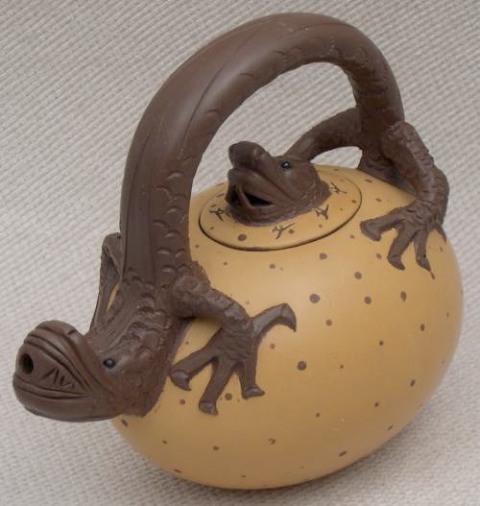They may be small, but what they lack in size they make up in originality and creative design.
Yixing pots (yee-shing), named after the town where they are crafted, are prized by collectors all over the world.
You can also see a selection of contemporary Chinese Yixing pots and enjoy a cup of Souvia® tea at the Phoenix Art Museum where the Asian Art department features an exhibit of Yixing pots from the James T. Bialac Collection entitled “Tea and Immortality.” The exhibit runs March 31 thru April 25th.
 What makes these tea pots so special? It is the clay (zisha) they are made out of? The clay, which can only be found in the southern portion of Jiangsu province, about 120 miles northwest of Shanghai in China, has three characteristic colors: light buff, cinnabar red and purplish brown. The blue and dusty black also found with Yixing pots is achieved by mixing certain minerals into the clay. Tea aficionados consider Yixing pots superior vessels for tea brewing because the purple clay is porous and absorbs small amounts of tea with every brewing. The patina which develops over time retains some of the flavor and scent of the tea brewed in the pot which explains why it is best to choose one particular (your favorite) tea for brewing in this pot. Some tea drinkers will swear that after repeated use you can fill the pot with hot water and still get a good cup of tea out of it. Typically used for Oolong teas, these pots only hold a small amount of water. But, this allows for maximum tea/water contact producing a great cup of tea. Most oolong teas can be infused three or more times in these pots making them as functional as larger pots, despite their size.
What makes these tea pots so special? It is the clay (zisha) they are made out of? The clay, which can only be found in the southern portion of Jiangsu province, about 120 miles northwest of Shanghai in China, has three characteristic colors: light buff, cinnabar red and purplish brown. The blue and dusty black also found with Yixing pots is achieved by mixing certain minerals into the clay. Tea aficionados consider Yixing pots superior vessels for tea brewing because the purple clay is porous and absorbs small amounts of tea with every brewing. The patina which develops over time retains some of the flavor and scent of the tea brewed in the pot which explains why it is best to choose one particular (your favorite) tea for brewing in this pot. Some tea drinkers will swear that after repeated use you can fill the pot with hot water and still get a good cup of tea out of it. Typically used for Oolong teas, these pots only hold a small amount of water. But, this allows for maximum tea/water contact producing a great cup of tea. Most oolong teas can be infused three or more times in these pots making them as functional as larger pots, despite their size.
Yixing pots are hand-crafted and often multiple colors are applied and inlaid to achieve the unique and fascinating designs. There are hundreds of styles, shapes, and designs available from simple to intricate. Yixing remains the center of tea production and tea culture in China, and Yixing teawares remain lively and creative, yet linked to a historical tradition.
Copyright 2006 Souvia and Tea-sentials, LLC all rights reserved


 What makes these tea pots so special? It is the clay (zisha) they are made out of? The clay, which can only be found in the southern portion of Jiangsu province, about 120 miles northwest of Shanghai in China, has three characteristic colors: light buff, cinnabar red and purplish brown. The blue and dusty black also found with Yixing pots is achieved by mixing certain minerals into the clay. Tea aficionados consider Yixing pots superior vessels for tea brewing because the purple clay is porous and absorbs small amounts of tea with every brewing. The patina which develops over time retains some of the flavor and scent of the tea brewed in the pot which explains why it is best to choose one particular (your favorite) tea for brewing in this pot. Some tea drinkers will swear that after repeated use you can fill the pot with hot water and still get a good cup of tea out of it. Typically used for Oolong teas, these pots only hold a small amount of water. But, this allows for maximum tea/water contact producing a great cup of tea. Most oolong teas can be infused three or more times in these pots making them as functional as larger pots, despite their size.
What makes these tea pots so special? It is the clay (zisha) they are made out of? The clay, which can only be found in the southern portion of Jiangsu province, about 120 miles northwest of Shanghai in China, has three characteristic colors: light buff, cinnabar red and purplish brown. The blue and dusty black also found with Yixing pots is achieved by mixing certain minerals into the clay. Tea aficionados consider Yixing pots superior vessels for tea brewing because the purple clay is porous and absorbs small amounts of tea with every brewing. The patina which develops over time retains some of the flavor and scent of the tea brewed in the pot which explains why it is best to choose one particular (your favorite) tea for brewing in this pot. Some tea drinkers will swear that after repeated use you can fill the pot with hot water and still get a good cup of tea out of it. Typically used for Oolong teas, these pots only hold a small amount of water. But, this allows for maximum tea/water contact producing a great cup of tea. Most oolong teas can be infused three or more times in these pots making them as functional as larger pots, despite their size.